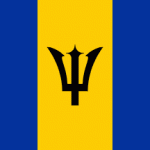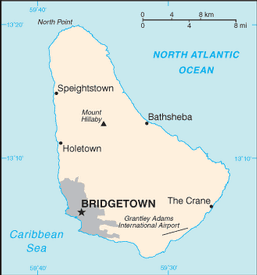BACKGROUND:
The island was uninhabited when first settled by the British in 1627. Slaves worked the sugar plantations established on the island until 1834 when slavery was abolished. The economy remained heavily dependent on sugar, rum, and molasses production through most of the 20th century. The gradual introduction of social and political reforms in the 1940s and 1950s led to complete independence from the UK in 1966. In the 1990s, tourism and manufacturing surpassed the sugar industry in economic importance.
————————————————————————————————————————
GEOGRAPHY:
Caribbean, island in the North Atlantic Ocean, northeast of Venezuela
Geographic coordinates:
13 10 N, 59 32 W
Geographic coordinates:
13 10 N, 59 32 W
Map references:
Central America and the Caribbean
Central America and the Caribbean
Area:
total: 430 sq km
total: 430 sq km
country comparison to the world: 201
land: 430 sq km
water: 0 sq km
land: 430 sq km
water: 0 sq km
Area – comparative:
2.5 times the size of Washington, DC
Land boundaries:
0 km
Coastline:
97 km
0 km
Coastline:
97 km
Maritime claims:
territorial sea: 12 nm
exclusive economic zone: 200 nm
territorial sea: 12 nm
exclusive economic zone: 200 nm
Climate:
tropical; rainy season (June to October)
tropical; rainy season (June to October)
Terrain:
relatively flat; rises gently to central highland region
relatively flat; rises gently to central highland region
Elevation extremes:
lowest point: Atlantic Ocean 0 m
highest point: Mount Hillaby 336 m
lowest point: Atlantic Ocean 0 m
highest point: Mount Hillaby 336 m
Natural resources:
petroleum, fish, natural gas
Land use:
arable land: 37.21%
permanent crops: 2.33%
other: 60.46% (2005)
petroleum, fish, natural gas
Land use:
arable land: 37.21%
permanent crops: 2.33%
other: 60.46% (2005)
Irrigated land:
50 sq km (2008)
Total renewable water resources:
0.1 cu km (2003)
Freshwater withdrawal (domestic/industrial/agricultural):
total: 0.09 cu km/yr (33%/44%/22%)
per capita: 333 cu m/yr (2000)
50 sq km (2008)
Total renewable water resources:
0.1 cu km (2003)
Freshwater withdrawal (domestic/industrial/agricultural):
total: 0.09 cu km/yr (33%/44%/22%)
per capita: 333 cu m/yr (2000)
Natural hazards:
infrequent hurricanes; periodic landslide
infrequent hurricanes; periodic landslide
Environment – current issues:
Pollution of coastal waters from waste disposal by ships; soil erosion; illegal solid waste disposal threatens contamination of aquifers
Pollution of coastal waters from waste disposal by ships; soil erosion; illegal solid waste disposal threatens contamination of aquifers
Environment – international agreements:
party to: Biodiversity, Climate Change, Climate Change-Kyoto Protocol, Desertification, Endangered Species, Hazardous Wastes, Law of the Sea, Marine Dumping, Ozone Layer Protection, Ship Pollution, Wetlands
signed, but not ratified: none of the selected agreements
party to: Biodiversity, Climate Change, Climate Change-Kyoto Protocol, Desertification, Endangered Species, Hazardous Wastes, Law of the Sea, Marine Dumping, Ozone Layer Protection, Ship Pollution, Wetlands
signed, but not ratified: none of the selected agreements
Geography – note:
easternmost Caribbean island
easternmost Caribbean island
————————————————————————————————————————
PEOPLE AND SOCIETY:
Nationality:
noun: Barbadian(s) or Bajan (colloquial)
adjective: Barbadian or Bajan (colloquial)
noun: Barbadian(s) or Bajan (colloquial)
adjective: Barbadian or Bajan (colloquial)
Ethnic groups:
black 93%, white 3.2%, mixed 2.6%, East Indian 1%, other 0.2% (2000 census)
black 93%, white 3.2%, mixed 2.6%, East Indian 1%, other 0.2% (2000 census)
Languages:
English
English
Religions:
Protestant 63.4% (Anglican 28.3%, Pentecostal 18.7%, Methodist 5.1%, other 11.3%), Roman Catholic 4.2%, other Christian 7%, other 4.8%, none or unspecified 20.6% (2008 est.)
Protestant 63.4% (Anglican 28.3%, Pentecostal 18.7%, Methodist 5.1%, other 11.3%), Roman Catholic 4.2%, other Christian 7%, other 4.8%, none or unspecified 20.6% (2008 est.)
Population:
287,733 (July 2012 est.)
country comparison to the world: 180
287,733 (July 2012 est.)
country comparison to the world: 180
Age structure:
0-14 years: 18.9% (male 27,127/female 27,127)
15-64 years: 71.3% (male 100,594/female 103,751)
65 years and over: 9.8% (male 10,982/female 17,124) (2011 est.)
0-14 years: 18.9% (male 27,127/female 27,127)
15-64 years: 71.3% (male 100,594/female 103,751)
65 years and over: 9.8% (male 10,982/female 17,124) (2011 est.)
Median age:
total: 36.5 years
male: 35.4 years
female: 37.6 years (2011 est.)
total: 36.5 years
male: 35.4 years
female: 37.6 years (2011 est.)
Population growth rate:
0.354% (2012 est.)
country comparison to the world: 162
0.354% (2012 est.)
country comparison to the world: 162
Birth rate:
12.23 births/1,000 population (2012 est.)
country comparison to the world: 161
12.23 births/1,000 population (2012 est.)
country comparison to the world: 161
Death rate:
8.39 deaths/1,000 population (July 2012 est.)
country comparison to the world: 86
8.39 deaths/1,000 population (July 2012 est.)
country comparison to the world: 86
Net migration rate:
-0.3 migrant(s)/1,000 population (2012 est.)
country comparison to the world: 129
-0.3 migrant(s)/1,000 population (2012 est.)
country comparison to the world: 129
Urbanization:
urban population: 44% of total population (2010)
rate of urbanization: 1.7% annual rate of change (2010-15 est.)
urban population: 44% of total population (2010)
rate of urbanization: 1.7% annual rate of change (2010-15 est.)
Major cities – population:
BRIDGETOWN (capital) 112,000 (2009)
Sex ratio:
at birth: 1.01 male(s)/female
under 15 years: 1 male(s)/female
15-64 years: 0.97 male(s)/female
65 years and over: 0.65 male(s)/female
total population: 0.94 male(s)/female (2012 est.)
at birth: 1.01 male(s)/female
under 15 years: 1 male(s)/female
15-64 years: 0.97 male(s)/female
65 years and over: 0.65 male(s)/female
total population: 0.94 male(s)/female (2012 est.)
Maternal mortality rate:
64 deaths/100,000 live births (2008)
country comparison to the world: 89
64 deaths/100,000 live births (2008)
country comparison to the world: 89
Infant mortality rate:
total: 11.63 deaths/1,000 live births
country comparison to the world: 133
male: 12.98 deaths/1,000 live births
female: 10.27 deaths/1,000 live births (2012 est.)
total: 11.63 deaths/1,000 live births
country comparison to the world: 133
male: 12.98 deaths/1,000 live births
female: 10.27 deaths/1,000 live births (2012 est.)
Life expectancy at birth:
total population: 74.52 years
country comparison to the world: 102
male: 72.25 years
female: 76.82 years (2012 est.)
total population: 74.52 years
country comparison to the world: 102
male: 72.25 years
female: 76.82 years (2012 est.)
Total fertility rate:
1.68 children born/woman (2012 est.)
country comparison to the world: 170
1.68 children born/woman (2012 est.)
country comparison to the world: 170
Health expenditures:
6.8% of GDP (2009)
country comparison to the world: 86
6.8% of GDP (2009)
country comparison to the world: 86
Physicians density:
1.811 physicians/1,000 population (2005)
country comparison to the world: 72
1.811 physicians/1,000 population (2005)
country comparison to the world: 72
Hospital bed density:
7.6 beds/1,000 population (2008)
country comparison to the world: 10
7.6 beds/1,000 population (2008)
country comparison to the world: 10
Drinking water source:
improved:
urban: 100% of population
rural: 100% of population
total: 100% of population (2008)
improved:
urban: 100% of population
rural: 100% of population
total: 100% of population (2008)
Sanitation facility access:
improved:
urban: 100% of population
rural: 100% of population
total: 100% of population (2008)
improved:
urban: 100% of population
rural: 100% of population
total: 100% of population (2008)
HIV/AIDS – adult prevalence rate:
1.4% (2009 est.)
country comparison to the world: 37
1.4% (2009 est.)
country comparison to the world: 37
HIV/AIDS – people living with HIV/AIDS:
2,100 (2009 est.)
country comparison to the world: 134
2,100 (2009 est.)
country comparison to the world: 134
HIV/AIDS – deaths:
fewer than 100 (2009 est.)
country comparison to the world: 148
fewer than 100 (2009 est.)
country comparison to the world: 148
Education expenditures:
6.7% of GDP (2008)
country comparison to the world: 19
6.7% of GDP (2008)
country comparison to the world: 19
Literacy:
definition: age 15 and over has ever attended school
total population: 99.7%
male: 99.7%
female: 99.7% (2002 est.)
definition: age 15 and over has ever attended school
total population: 99.7%
male: 99.7%
female: 99.7% (2002 est.)
School life expectancy (primary to tertiary education):
total: 13 years
male: 13 years
female: 14 years (2001)
total: 13 years
male: 13 years
female: 14 years (2001)
Unemployment, youth ages 15-24:
total: 26.2%
country comparison to the world: 23
male: 24.1%
female: 28.7% (2003)
total: 26.2%
country comparison to the world: 23
male: 24.1%
female: 28.7% (2003)
————————————————————————————————–



